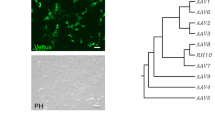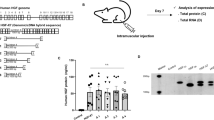Abstract
Hepatocyte growth factor (HGF) promotes regeneration of the central nervous system, but its effects on the peripheral nervous system remain unclear. This study was conducted to elucidate the effect of HGF on regeneration of the murine facial nerve after crush injury. To do so, a replication-defective herpes simplex virus vector that incorporated HGF was prepared (HSV-HGF). The main trunk of the facial nerve was compressed by mosquito hemostats, and HSV-HGF, control vector or medium was then applied to the compressed nerve. We found that mice in the HGF group required significantly fewer days for complete recovery from nerve compression. Furthermore, the amplitude of the evoked buccinator muscle compound action potential increased following HSV-HGF application. HGF expression in and around the compressed nerve was demonstrated by enzyme-linked immunoassay and immunohistochemistry. In addition, HSV-HGF introduction around the damaged nerve significantly accelerated recovery of function of the facial nerve. These data suggest a possible role of HGF in promoting facial nerve regeneration after nerve damage. Furthermore, this viral delivery method may be applied clinically for many types of severe facial palsy during facial nerve decompression surgery.
This is a preview of subscription content, access via your institution
Access options
Subscribe to this journal
Receive 12 print issues and online access
$259.00 per year
only $21.58 per issue
Buy this article
- Purchase on Springer Link
- Instant access to full article PDF
Prices may be subject to local taxes which are calculated during checkout






Similar content being viewed by others
References
Sendtner M, Kreutzberg GW, Thoenen H . Ciliary neurotrophic factor prevents the degeneration of motor neurons after axotomy. Nature 1990; 345: 440–441.
Koliatsos VE, Cayouette MH, Berkemeier LR, Clatterbuck RE, Price DL, Rosenthal A . Neurotrophin 4/5 is a trophic factor for mammalian facial motor neurons. Proc Natl Acad Sci USA 1994; 91: 3304–3308.
Hughes RA, Sendtner M, Thoenen H . Members of several gene families influence survival of rat motoneurons in vitro and in vivo. J Neurosci Res 1993; 36: 663–671.
Sendtner M, Dittrich F, Hughes RA, Thoenen H . Actions of CNTF and neurotrophins on degenerating motoneurons: preclinical studies and clinical implications. J Neurol Sci 1994; 124 (Suppl): 77–83.
Spector JG, Lee P, Derby A, Frierdich GE, Neises G, Roufa DG . Rabbit facial nerve regeneration in NGF-containing silastic tubes. Laryngoscope 1993; 103: 548–558.
Li L, Oppenheim RW, Lei M, Houenou LJ . Neurotrophic agents prevent motoneuron death following sciatic nerve section in the neonatal mouse. J Neurobiol 1994; 25: 759–766.
Barras FM, Pasche P, Bouche N, Aebischer P, Zurn AD . Glial cell line-derived neurotrophic factor released by synthetic guidance channels promotes facial nerve regeneration in the rat. J Neurosci Res 2002; 70: 746–755.
Kohmura E, Yuguchi T, Yoshimine T, Fujinaka T, Koseki N, Sano A et al. BDNF atelocollagen mini-pellet accelerates facial nerve regeneration. Brain Res 1999; 849: 235–238.
Mohiuddin L, Delcroix JD, Fernyhough P, Tomlinson DR . Focally administered nerve growth factor suppresses molecular regenerative responses of axotomized peripheral afferents in rats. Neuroscience 1999; 91: 265–271.
Nakamura T, Nawa K, Ichihara A . Partial purification and characterization of hepatocyte growth factor from serum of hepatectomized rats. Biochem Biophys Res Commun 1984; 122: 1450–1459.
Nakamura T, Nishizawa T, Hagiya M, Seki T, Shimonishi M, Sugimura A et al. Molecular cloning and expression of human hepatocyte growth factor. Nature 1989; 342: 440–443.
Bottaro DP, Rubin JS, Faletto DL, Chan AM, Kmiecik TE, Vande Woude GF et al. Identification of the hepatocyte growth factor receptor as the c-met proto-oncogene product. Science 1991; 251: 802–804.
Hayashi K, Morishita R, Nakagami H, Yoshimura S, Hara A, Matsumoto K et al. Gene therapy for preventing neuronal death using hepatocyte growth factor: in vivo gene transfer of HGF to subarachnoid space prevents delayed neuronal death in gerbil hippocampal CA1 neurons. Gene Therapy 2001; 8: 1167–1173.
Caton A, Hacker A, Naeem A, Livet J, Maina F, Bladt F et al. The branchial arches and HGF are growth-promoting and chemoattractant for cranial motor axons. Development 2000; 127: 1751–1766.
Hamanoue M, Takemoto N, Matsumoto K, Nakamura T, Nakajima K, Kohsaka S . Neurotrophic effect of hepatocyte growth factor on central nervous system neurons in vitro. J Neurosci Res 1996; 43: 554–564.
Jin H, Yang R, Li W, Ogasawara AK, Schwall R, Eberhard DA et al. Early treatment with hepatocyte growth factor improves cardiac function in experimental heart failure induced by myocardial infarction. J Pharmacol Exp Ther 2003; 304: 654–660.
Maina F, Klein R . Hepatocyte growth factor, a versatile signal for developing neurons. Nat Neurosci 1999; 2: 213–217.
Matsumoto K, Nakamura T . Hepatocyte growth factor (HGF) as a tissue organizer for organogenesis and regeneration. Biochem Biophys Res Commun 1997; 239: 639–644.
Sun W, Funakoshi H, Nakamura T . Overexpression of HGF retards disease progression and prolongs life span in a transgenic mouse model of ALS. J Neurosci 2002; 22: 6537–6548.
Sun W, Funakoshi H, Nakamura T . Localization and functional role of hepatocyte growth factor (HGF) and its receptor c-met in the rat developing cerebral cortex. Brain Res Mol Brain Res 2002; 103: 36–48.
Kitamura K, Iwanami A, Nakamura M, Yamane J, Watanabe K, Suzuki Y et al. Hepatocyte growth factor promotes endogenous repair and functional recovery after spinal cord injury. J Neurosci Res 2007; 85: 2332–2342.
Shimamura M, Sato N, Oshima K, Aoki M, Kurinami H, Waguri S et al. Novel therapeutic strategy to treat brain ischemia: overexpression of hepatocyte growth factor gene reduced ischemic injury without cerebral edema in rat model. Circulation 2004; 109: 424–431.
Shimamura M, Sato N, Waguri S, Uchiyama Y, Hayashi T, Iida H et al. Gene transfer of hepatocyte growth factor gene improves learning and memory in the chronic stage of cerebral infarction. Hypertension 2006; 47: 742–751.
Carnicero E, Knipper M, Tan J, Alonso MT, Schimmang T . Herpes simplex virus type 1-mediated transfer of neurotrophin-3 stimulates survival of chicken auditory sensory neurons. Neurosci Lett 2002; 321: 149–152.
Chattopadhyay M, Goss J, Wolfe D, Goins WC, Huang S, Glorioso JC et al. Protective effect of herpes simplex virus-mediated neurotrophin gene transfer in cisplatin neuropathy. Brain 2004; 127: 929–939.
Kato R, Wolfe D, Coyle CH, Huang S, Wechuck JB, Goins WF et al. Herpes simplex virus vector-mediated delivery of glial cell line-derived neurotrophic factor rescues erectile dysfunction following cavernous nerve injury. Gene Therapy 2007; 14: 1344–1352.
Kato R, Wolfe D, Coyle CH, Wechuck JB, Tyagi P, Tsukamoto T et al. Herpes simplex virus vector-mediated delivery of neurturin rescues erectile dysfunction of cavernous nerve injury. Gene Therapy 2009; 16: 26–33.
Walwyn WM, Matsuka Y, Arai D, Bloom DC, Lam H, Tran C et al. HSV-1-mediated NGF delivery delays nociceptive deficits in a genetic model of diabetic neuropathy. Exp Neurol 2006; 198: 260–270.
Coffin RS, MacLean AR, Latchman DS, Brown SM . Gene delivery to the central and peripheral nervous systems of mice using HSV1 ICP34.5 deletion mutant vectors. Gene Therapy 1996; 3: 886–891.
Coffin RS, Thomas SK, Thomas DP, Latchman DS . The herpes simplex virus 2 kb latency associated transcript (LAT) leader sequence allows efficient expression of downstream proteins which is enhanced in neuronal cells: possible function of LAT ORFs. J Gen Virol 1998; 79 (Part 12): 3019–3026.
Palmer JA, Branston RH, Lilley CE, Robinson MJ, Groutsi F, Smith J et al. Development and optimization of herpes simplex virus vectors for multiple long-term gene delivery to the peripheral nervous system. J Virol 2000; 74: 5604–5618.
Lilley CE, Branston RH, Coffin RS . Herpes simplex virus vectors for the nervous system. Curr Gene Ther 2001; 1: 339–358.
Lindsay RM . Role of neurotrophins and trk receptors in the development and maintenance of sensory neurons: an overview. Philos Trans R Soc Lond B Biol Sci 1996; 351: 365–373.
Federoff HJ, Geschwind MD, Geller AI, Kessler JA . Expression of nerve growth factor in vivo from a defective herpes simplex virus 1 vector prevents effects of axotomy on sympathetic ganglia. Proc Natl Acad Sci USA 1992; 89: 1636–1640.
Gravel C, Gotz R, Lorrain A, Sendtner M . Adenoviral gene transfer of ciliary neurotrophic factor and brain-derived neurotrophic factor leads to long-term survival of axotomized motor neurons. Nat Med 1997; 3: 765–770.
Hadlock TA, Heaton J, Cheney M, Mackinnon SE . Functional recovery after facial and sciatic nerve crush injury in the rat. Arch Facial Plast Surg 2005; 7: 17–20.
Most SP . Facial nerve recovery in bcl2 overexpression mice after crush injury. Arch Facial Plast Surg 2004; 6: 82–87.
Serpe CJ, Sanders VM, Jones KJ . Kinetics of facial motoneuron loss following facial nerve transection in severe combined immunodeficient mice. J Neurosci Res 2000; 62: 273–278.
Esslen E . A method of demonstrating and measuring disturbances of central innervation: electrotonomyography. Electroencephalogr Clin Neurophysiol 1967; 23: 387.
Honda N, Hato N, Takahashi H, Wakisaka H, Kisaki H, Murakami S et al. Pathophysiology of facial nerve paralysis induced by herpes simplex virus type 1 infection. Ann Otol Rhinol Laryngol 2002; 111: 616–622.
Engstrom M, Jonsson L, Grindlund M, Stalberg E . House-Brackmann and Yanagihara grading scores in relation to electroneurographic results in the time course of Bell's palsy. Acta Otolaryngol 1998; 118: 783–789.
Sugita T, Murakami S, Yanagihara N, Fujiwara Y, Hirata Y, Kurata T . Facial nerve paralysis induced by herpes simplex virus in mice: an animal model of acute and transient facial paralysis. Ann Otol Rhinol Laryngol 1995; 104: 574–581.
Murakami S, Mizobuchi M, Nakashiro Y, Doi T, Hato N, Yanagihara N . Bell palsy and herpes simplex virus: identification of viral DNA in endoneurial fluid and muscle. Ann Intern Med 1996; 124: 27–30.
Nishiyama Y . Herpes simplex virus gene products: the accessories reflect her lifestyle well. Rev Med Virol 2004; 14: 33–46.
Komobuchi H, Hato N, Teraoka M, Wakisaka H, Takahashi H, Gyo K et al. Basic fibroblast growth factor combined with biodegradable hydrogel promotes healing of facial nerve after compression injury: an experimental study. Acta Otolaryngol 2010; 130: 173–178.
Zhao MZ, Nonoguchi N, Ikeda N, Watanabe T, Furutama D, Miyazawa D et al. Novel therapeutic strategy for stroke in rats by bone marrow stromal cells and ex vivo HGF gene transfer with HSV-1 vector. J Cereb Blood Flow Metab 2006; 26: 1176–1188.
Liu Y, Michalopoulos GK, Zarnegar R . Molecular cloning and characterization of cDNA encoding mouse hepatocyte growth factor. Biochim Biophys Acta 1993; 1216: 299–303.
Esaki S, Goshima F, Katsumi S, Watanabe D, Ozaki N, Murakami S et al. Apoptosis induction after herpes simplex virus infection differs according to cell type in vivo. Arch Virol 2010; 155: 1235–1245.
Acknowledgements
This work was supported by a Grant-in-Aid from the Japan Society for the Promotion of Science (19591984).
Author information
Authors and Affiliations
Corresponding author
Ethics declarations
Competing interests
The authors declare no conflict of interest.
Rights and permissions
About this article
Cite this article
Esaki, S., Kitoh, J., Katsumi, S. et al. Hepatocyte growth factor incorporated into herpes simplex virus vector accelerates facial nerve regeneration after crush injury. Gene Ther 18, 1063–1069 (2011). https://doi.org/10.1038/gt.2011.57
Received:
Revised:
Accepted:
Published:
Issue Date:
DOI: https://doi.org/10.1038/gt.2011.57
Keywords
This article is cited by
-
The effect of insulin-like growth factor 1 on the recovery of facial nerve function in a guinea pig model of facial palsy
The Journal of Physiological Sciences (2020)
-
The effect of memantine on functional recovery of the facial nerve after crush injury
European Archives of Oto-Rhino-Laryngology (2015)



